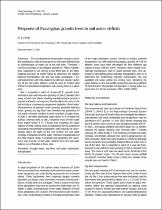JavaScript is disabled for your browser. Some features of this site may not work without it.
- ResearchSpace
- →
- Research Publications/Outputs
- →
- Journal Articles
- →
- View Item
| dc.contributor.author |
Dye, PJ

|
|
| dc.date.accessioned | 2007-06-29T06:07:19Z | |
| dc.date.available | 2007-06-29T06:07:19Z | |
| dc.date.issued | 1996-01 | |
| dc.identifier.citation | Dye, PJ. 1996. Response of Eucalyptus grandis trees to soil water deficits. Tree Physiology, vol. 16, 02 January, pp 233-238 | en |
| dc.identifier.issn | 0829-318x | |
| dc.identifier.uri | http://hdl.handle.net/10204/714 | |
| dc.description | Copyright: 1996 Heron Publishing | en |
| dc.description.abstract | The use of potential transpiration models to simulate transpiration rates in areas prone to soil water deficits leads to overestimates of water use as the soil dries. Therefore, the author carried out studies on Eucalyptus grandis W. Hill ex Maiden. Trees subjected to soil drying at two field sites in the Mpumalanga province of South Africa to determine the relation between transpiration rate and soil water availability. The author hypothesized that, with this relationship defined, simple modelling of the soil water balance could be used to predict what fraction of potential transpiration was taking place at a given time. Site 1 supported a stand of 3-year-old E. grandis trees, whereas 9-year-old trees were growing on Site 2, situated 2 km away. At each site, plastic sheeting was laid over the ground to prevent soil water recharge and thereby allow the roots in the soil to induce a continuous progressive depletion of soil water. Measurements of predawn xylem pressure potential, leaf area index, growth, and sap flow rates revealed that prevention of soil water recharge resulted in only moderate drought stress. At Site 1, the trees abstracted water down to 8 m below the surface, whereas trees at Site 2 obtained most of their water from depths below 8 m. I found that modelling the water balance of deep rooting zones is impractical for the purpose of simulating nonpotential transpiration rates because of uncertainties about the depth of the root system, the soil water recharge mechanism and the water retention characteristics of the deep subsoil strata. I conclude that predicting the occurrence and severity of soil water deficits from the soil water balance is not feasible at these sites. | en |
| dc.language.iso | en | en |
| dc.publisher | Heron Publishinn | en |
| dc.subject | Drought stress | en |
| dc.subject | Sap flow | en |
| dc.subject | Soil water abstractions | en |
| dc.subject | Transpirations | en |
| dc.title | Response of Eucalyptus grandis trees to soil water deficits | en |
| dc.type | Article | en |
| dc.identifier.apacitation | Dye, P. (1996). Response of Eucalyptus grandis trees to soil water deficits. http://hdl.handle.net/10204/714 | en_ZA |
| dc.identifier.chicagocitation | Dye, PJ "Response of Eucalyptus grandis trees to soil water deficits." (1996) http://hdl.handle.net/10204/714 | en_ZA |
| dc.identifier.vancouvercitation | Dye P. Response of Eucalyptus grandis trees to soil water deficits. 1996; http://hdl.handle.net/10204/714. | en_ZA |
| dc.identifier.ris | TY - Article AU - Dye, PJ AB - The use of potential transpiration models to simulate transpiration rates in areas prone to soil water deficits leads to overestimates of water use as the soil dries. Therefore, the author carried out studies on Eucalyptus grandis W. Hill ex Maiden. Trees subjected to soil drying at two field sites in the Mpumalanga province of South Africa to determine the relation between transpiration rate and soil water availability. The author hypothesized that, with this relationship defined, simple modelling of the soil water balance could be used to predict what fraction of potential transpiration was taking place at a given time. Site 1 supported a stand of 3-year-old E. grandis trees, whereas 9-year-old trees were growing on Site 2, situated 2 km away. At each site, plastic sheeting was laid over the ground to prevent soil water recharge and thereby allow the roots in the soil to induce a continuous progressive depletion of soil water. Measurements of predawn xylem pressure potential, leaf area index, growth, and sap flow rates revealed that prevention of soil water recharge resulted in only moderate drought stress. At Site 1, the trees abstracted water down to 8 m below the surface, whereas trees at Site 2 obtained most of their water from depths below 8 m. I found that modelling the water balance of deep rooting zones is impractical for the purpose of simulating nonpotential transpiration rates because of uncertainties about the depth of the root system, the soil water recharge mechanism and the water retention characteristics of the deep subsoil strata. I conclude that predicting the occurrence and severity of soil water deficits from the soil water balance is not feasible at these sites. DA - 1996-01 DB - ResearchSpace DP - CSIR KW - Drought stress KW - Sap flow KW - Soil water abstractions KW - Transpirations LK - https://researchspace.csir.co.za PY - 1996 SM - 0829-318x T1 - Response of Eucalyptus grandis trees to soil water deficits TI - Response of Eucalyptus grandis trees to soil water deficits UR - http://hdl.handle.net/10204/714 ER - | en_ZA |






